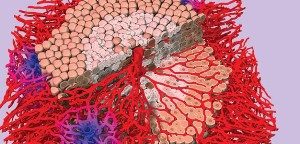
Can a damaged liver regenerate and recover from the damage? The answer is both yes and no, depending on the cause of the damage. An otherwise healthy liver can indeed regenerate from damage, even very severe damage. However, some liver diseases, notably fibrosis and cirrhosis of the liver, cause liver damage that cannot be regenerated and is irrecoverable. Treatment of progressive liver diseases of this kind consists of arrestin the progress of the disease and preserving as much liver function as possible.
Regeneration In A Healthy Liver
Regeneration of a damaged but otherwise healthy liver is not only possible but remarkable. A healthy liver with up to three-
Partial Liver Transplant
This capacity of the liver to regenerate in both size and function is the basis for a medical procedure known as partial liver transplant or live donor liver transplant. Instead of transplanting the whole liver from a deceased donor, the transplant involves removing part of the healthy liver from a living donor and transplanting it to replace the diseased liver of a patient, which is removed in full. The partial livers in both the donor and the recipient both rapidly grow to full sized, full function livers. The advantage of this procedure over conventional transplant of full organs from a deceased donor is that the pool of organs for transplant becomes potentially much larger.
The size of the body and the necessary hepatic function seem to govern the limits of the regeneration. In a few cases, baboon livers have been transplanted into human patients. A baboon liver is smaller than a human liver, but the transplanted liver grows to the size of a human liver in order to fulfill the increased function demand.
Progressive Liver Diseases
In contrast to regeneration of healthy livers, some liver conditions, notably liver fibrosis and cirrhosis of the liver, do not allow for recovery or regeneration. The difference is that when part of the liver is damaged or surgically removed, an overall healthy liver mass remains as a base from which new liver tissue can be grown to replace what has been destroyed or removed. With liver fibrosis or cirrhosis of the liver, however, scar tissue forms throughout the liver and progressively interferes with liver functionality. This is not a loss of a part of the liver, but rather of a part of the functionality of the organ as a whole. There is no part of the liver that is simply lost, nor is there a healthy remainder that can generate new liver tissue.
Not all liver disease prevents the liver from regenerating. A disease that is localized such as liver cancer or that does not produce scarring throughout the liver can allow for full recovery of liver function even if it is very severe. This is usually the case with acute hepatitis, for example.
Alcohol And Liver Regeneration
The most common single cause of liver disease is alcohol abuse, although alcohol is responsible for a minority of liver disease from all causes. Alcohol causes progressive damage to the liver in the form of the growth of fatty deposits (fatty liver disease) and the development of scarring and fibrous growths throughout the organ (fibrosis or cirrhosis). These conditions are found throughout the liver in patients suffering from these diseases. As such, the damage to the liver from alcohol abuse is usually not recoverable. Cessation of drinking usually arrests the progress of the disease (unless other causes are also present), but does not repair the damage.